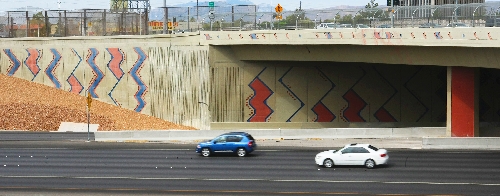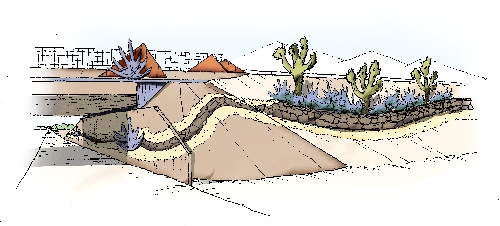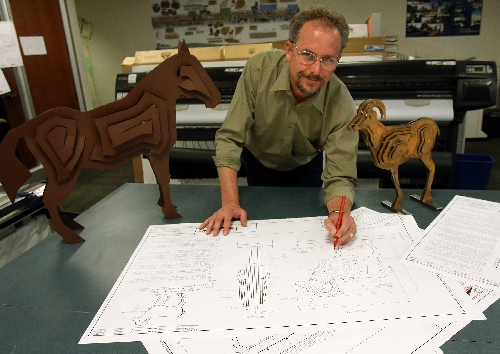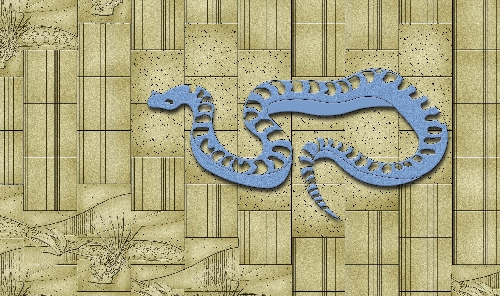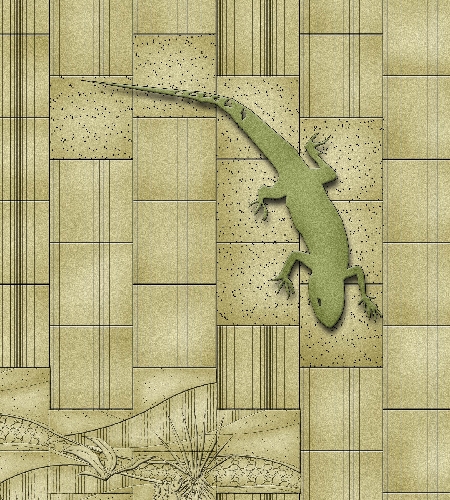Screens, artwork help decorate highways in Las Vegas
To visit the valley's latest art exhibition, take U.S. Highway 95 north from the Spaghetti Bowl. Don't exit anywhere. Just take it.
You'll find bridges and sound walls between Martin Luther King Jr. and Rainbow boulevards bursting with texture and color, and ramp-adjacent shoulders sprouting abstract steel screens.
The finishing touches are currently being applied to one of three valley road art projects that will, by 2013, also gussy up Interstate 15 between Tropicana Avenue and Blue Diamond Road, and U.S. 95 between the Rainbow Curve and Ann Road. (Beautification plans have yet to be announced for the busiest stretch of valley freeway: I-15 between Tropicana Avenue and downtown.)
"Art on the freeway gives the community a sense of ownership and identity," said Bob McKenzie, spokesman for the Nevada Department of Transportation.
Freeway art also reduces graffiti, according to McKenzie. I-15's Blue Diamond Road interchange was a frequent target before the Transportation Department applied a more conventionally artistic paint job in 2007. Since then, it has been tag-free.
"The blank gray walls are much more appetizing for them to go target than if the area has been taken care of," McKenzie said.
This may be because tags are less visible on beautified structures, because taggers fear their messages will be removed faster, or even because some may have an appreciation for art.
"Whatever the reason is," McKenzie said, "we're happy about it."
Since 2002, the Transportation Department has been required by law to allocate 3 percent of any new road construction or improvement funds for landscaping and aesthetics. Using this money, it hires various designers for roadway stretches. The steel screens were the vision of C.F. Shuler Inc. landscape architect Carol Shuler, who saw them as a perfect way to balance her size and budgetary needs.
"The areas are so huge, we had to get an element in there big enough that you'd see it," Shuler said of the screens, which exhausted $583,000 of her $3.1 million allotment.
Some screens display the spiral patterns of Paiute basketry; others, desert tortoises and their favorite snack, prickly pear cactus. (Shuler said tortoises "symbolize longevity in many cultures.")
Shuler's project also placed steel shade trees and decorative boulders on the residential side of the sound walls.
"That was a widening project, so a lot of houses were removed and a lot of half-lots left," she said. "You've got to clean that up."
While most of Shuler's project is up, its official completion waits for construction of a high-occupancy vehicle ramp from U.S. 95 to Summerlin Parkway next spring.
About that same time, Las Vegans will start seeing horses, burros and bighorn sheep along I-15 for six miles south of Tropicana Avenue. The 45 weathered steel structures, 10 to 12 feet tall, will stand on shoulders and bridges. This $246.5 million project began last year and is expected to wrap in spring 2012.
Project designer Stantec Consulting saw an opportunity to educate California visitors who may not realize that nature in Las Vegas transcends Siegfried & Roy's Magic Garden.
"You're driving through the desert to get to Las Vegas, but what you don't really understand is what's surrounding you besides the roadway edges," said Stantec managing senior associate Cary Baird, who is currently soliciting steel fabricators for the sculptures.
"There are a lot of interesting things that make Las Vegas more than just the perception the general public has about it."
Stantec also won a $70 million bid to spruce up U.S. 95 between the Rainbow Curve and Ann Road. Its plans here include six 20-foot steel mountains at the Rancho Drive interchange -- and smaller mountains on 11 bridges. That project broke ground earlier this month and is expected to summit in spring 2013.
"When you head north on the 95, right ahead of you is Sheep Mountain and we used that as an image," Baird said.
There is a model city for all of this, and it's no coincidence it's the one where Baird grew up and Shuler resides. The freeways of Phoenix are six-lane art galleries.
"I was inspired not by their imagery itself, but by its placement and use there," Baird said.
In 1982, the Arizona Department of Transportation became the nation's leading freeway art installer. At the time, its reasons were more political than altruistic. Designing its section of Interstate 10 with replica American Indian petroglyphs was an attempt to assuage Phoenicians who for years had fought to divert the interstate around their city.
"They thought freeways were ugly," Shuler recalled. "Aesthetics had been an unknown element on the roads there."
Shuler was the very landscape architect who designed the theme that now blankets Interstate 10 and every subsequent freeway built in Phoenix. And one difference between the Phoenix and Las Vegas projects, she said, might put Las Vegas in the aesthetic lead: Landscape architects here aren't held to a single theme or set of construction materials.
"The A-DOT thing of just petroglyphs and Indian designs is good in one way," Shuler said, "but it also gets kind of boring if you drive around town very much."
Contact reporter Corey Levitan at clevitan@reviewjournal.com or 702-383-0456.




